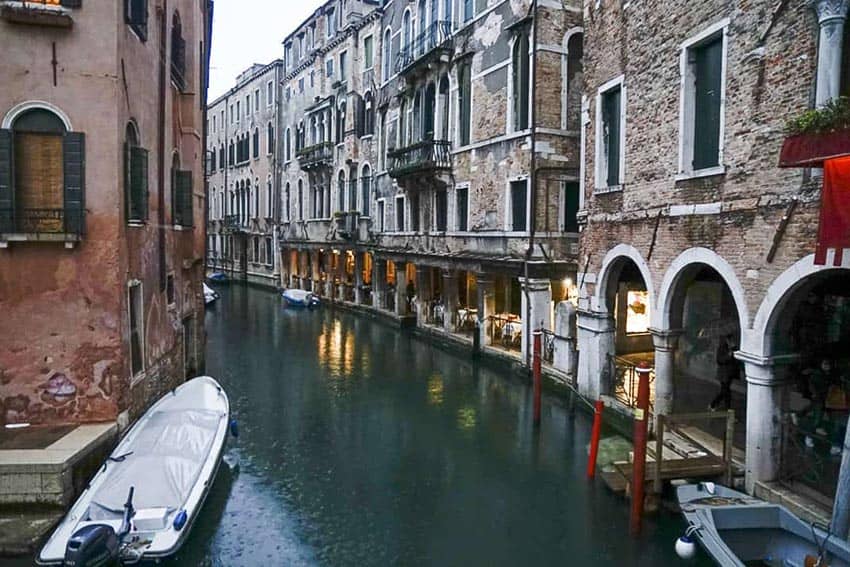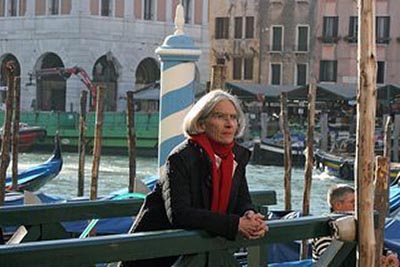
By Ann Banks
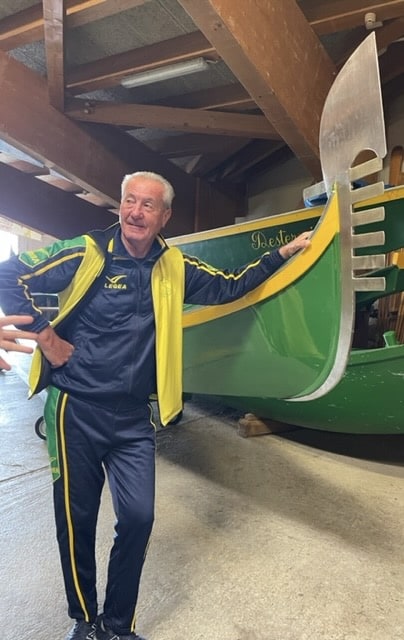
Venice is the most beautiful city in the world. It’s also the subject of the most hand-wringing, especially from afar: It’s sinking, it’s flooding, it’s overcrowded, there’s a drought.
Yet one major lament is no longer heard: since August 2021, giant cruise ships have been banned from the historic city center.
That is very good news for Venice’s fragile foundations – and also for anyone who might be planning to kayak there, as my husband and I did recently.
Our nine-day paddling tour was designed to feature both the shimmering natural beauty of Venice’s outer Lagoon with its scattered islands and the extravagant architectural delights of the (now cruise-ship free) Venetian cityscape.
As word of our trip got around, it prompted a certain amount of disbelief on the part of friends. One wrote: “You are KIDDING me!! You kayaked to VENICE?!!!”
Yes, we did. Not only to Venice but also in Venice. If I had to choose a single highlight for a souvenir T-shirt, it would say, “I paddled the Canal Grande.”
Our watery journey was possible because of guide extraordinaire Marco Venturini.
He masterminds multi-day kayak trips around the Mediterranean and Adriatic for groups of up to six people through his company travelinkayak.com.
Peter and I had taken an earlier one of these trips a few years ago and had learned of the Venice trip from a fellow paddler.
Our confidence in Marco was a deciding factor in signing up for this unusual adventure.
Peter and I are recreational kayakers but more than that, we are water people.
We love islands and there are more than 100 in the Lagoon’s 212 square miles. We love cities and Venice has been a city for more than 1,000 years.
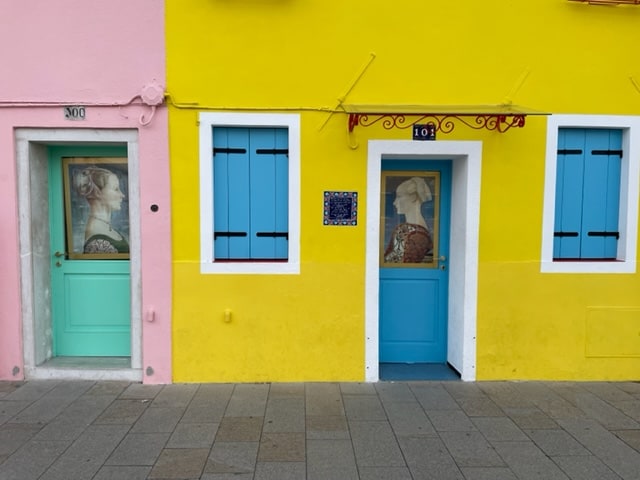
We began on small island of Burano, where we met Suellen and Tanner, who would be our companions on the tour. Our base for explorations of the outer Lagoon,
Burano is famous for, among other things, its palette. The houses are painted such flamboyant colors that from a distance the island appears to have been built out of Lego blocks.

The first morning we assembled at the headquarters of the Burano Rowing Club, where Marco introduced us to the bright blue double kayak that would be ours for the next week.
He’d arranged for us to meet club’s president, Franco De Rossi, a retired gondolier and current patriarch of a Venetian rowing family.
Of all the families in Venice, his has the exclusive honor of rowing the Pope when he comes to town.
After a few safety instructions, we set out from the club into the marshy shallows and channels of the northern Lagoon. We were stunned by the natural beauty – the crystal-clear water and riotously abundant bird life.
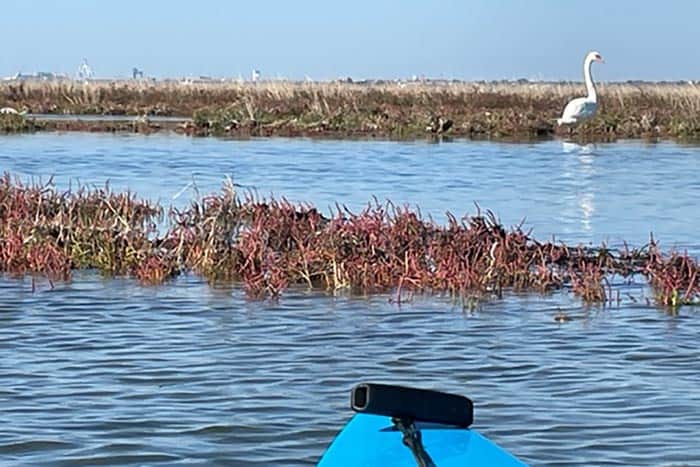
We spotted ibises, herons, egrets, ducks, and swans. And, most unexpectedly, a flock of rosy flamingos, attracted to the Lagoon by the fish farms.
There are many islands in paddling distance of Burano – more than we had time to visit. One morning, we paddled over to Torcello. Today Torcello is home to only a few residents, but the island was once more populated than Venice.

Sightseers arrive by ferry from the city center to visit the basilica of Santa Maria Assunta, the oldest landmark building in the Venetian Lagoon, dating from 639. I was eager to see the church myself.
Having read Mary McCarthy’s description of its famous mosaic in her book Venice Observed, I had to agree with her that the sinners descending to the torments of hell make for much livelier visuals than the pious on their way to heaven.
San Francisco del Deserto
Our next kayaking destination was San Francisco del Deserto, a serene cypress-lined island that is home to a Franciscan monastery.
“Del Deserto” refers to a period in the Middle Ages when the island had to be abandoned on account of an epidemic, a not-uncommon danger in these marshy lowlands.
Brother Carlo, one of five monks who reside on the island today, showed us around the cloister and gardens. He told the story of the Miracle of the Birds, an event that occurred during St Francis of Assisi’s time on the island.
When raucous songbirds interfered with a sermon he was preaching, he bade them be quiet and they complied.
After a few days of spent exploring the tranquil realm of places like these, I was as free of stress as if I had been on a meditation retreat.
Still, I felt slightly nervous at the prospect of kayaking from Burano into the city center.
It’s just nine kilometers as the crow flies, but I’d come to understand that the Lagoon is not a lake – it’s a huge tidal salt marsh laced with channels and shallows.
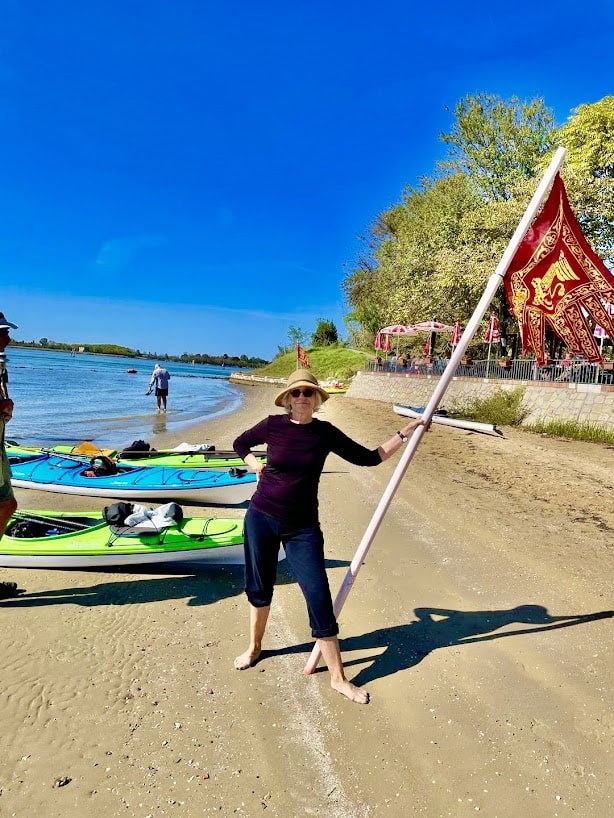
There is no straight line to follow from Burano to Venice. To make the passage in our kayaks, we needed to pay attention to the tides and follow Marco through hidden, mostly unmarked channels.
Many hours – and miles – after setting out from the Burano Rowing Club we paddled into the city itself.
It was a surreal experience to slip from the sparkling expanses of the Lagoon into the watery urban maze of the city’s canals. Our destination was the San Marco Basin and to get there we had to zigzag our way across the narrowest part of Venice.
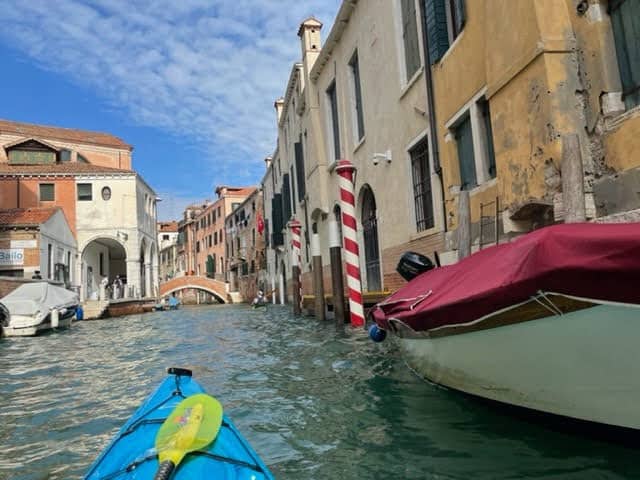
Looming over us on both sides were beautifully painted facades in faded hues of pink, terra cotta, and ochre. Gracefully arched footbridges spanned the canals and red and white striped mooring poles emerged from the water.
Black gondolas floated by, rowed by imperious standing gondoliers. A bit intimidated, we paid careful attention to Marco’s instructions on how to stay out of their way.
Canal safely navigated, we entered the busy San Marco Basin, teeming with every kind of vessel. On the southern edge, directly across from the hectic and crowded San Marco square, is a small, serene island that was to be our base for the next five days.

San Giorgio Maggiore is home to a famous Palladian church, a Benedictine cloister, a charitable foundation, and on the eastern edge, a marina belonging to the Venice Yacht Club.
Marco has membership privileges at this splendid institution, whose name — Compagnia della Vela –translates literally as the Company of Sailing.
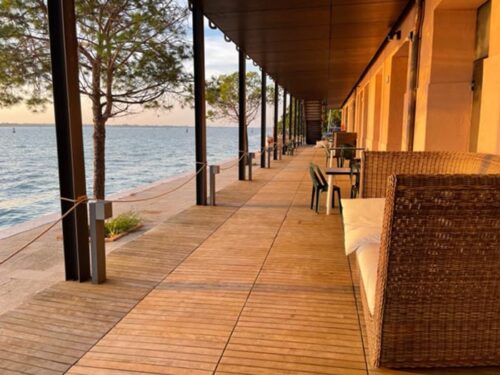
We were able to stay at its guest quarters at the water’s edge. Alongside the building was a launching ramp where we staged our kayaks in preparation for more exploring.
San Servolo First
Our first excursion was to San Servolo, a spot with the layered history typical of islands in the lagoon. It was a Benedictine monastery for 500 years and then served as a military hospital, a grain storage depot, and a place of quarantine for victims of the plague.
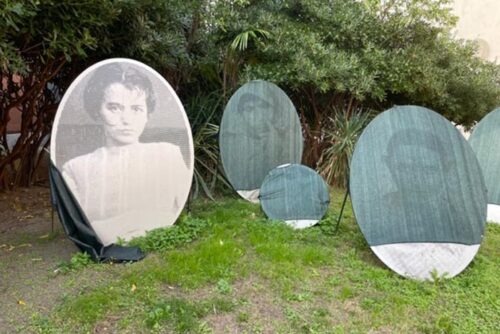
In 1725 it was repurposed yet again as the insane asylum of the city of Venice. It remained a psychiatric hospital until the 1970s when the wards closed for good.
Now it is an enchanting place, dominated by a luxuriant park, home to a foundation, several universities, and a conference center. Its past is still embodied in the red brick walls that encircle the campus.
At regular intervals, they feature large, picture window-shaped openings that frame painterly prospects of the lagoon.
Inviting Views of Venice
These are inviting views, except for the fact that the openings are barred. A small museum documents the island’s days as a mental hospital, and scattered around the grounds are haunting reproductions of photos of long-ago patients.
After a few days kayaking around the inner Lagoon, we got more confident about navigating amid the boat traffic. Marco deemed us ready for the excursion that was to be the high point of our Venice trip – a kayak in the Grand Canal.
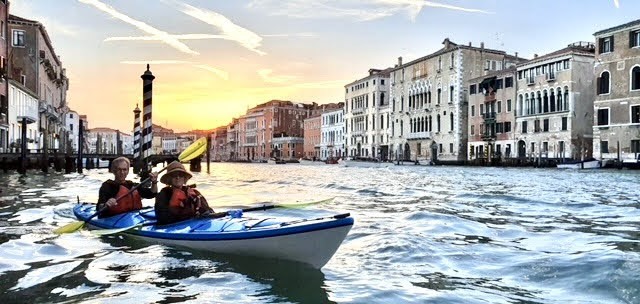
This turned out to be thrilling beyond measure – though far from relaxing. Following his lead, we managed to stay clear of the many gondolas, vaporettos, work boats, and water taxis. How he could take a picture of us without any other boats in the frame is a mystery.
To celebrate the success of this venture, Marco took us to dinner at the compagnia di vela clubhouse overlooking the San Marco Basin. We were joined by Grant Thompson, whose company Tofino Expeditions pioneered the Venice itinerary.
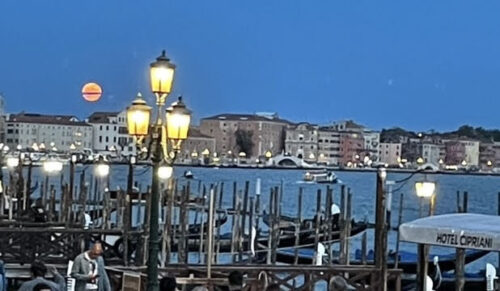
A magnificent full moon rose up to join the glowing street lamps illuminating the night. Proof, as if we needed it, that the startling beauty of Venice has not been dulled by centuries of praise.
Nine days earlier, putting in for the first time at the Burano Rowing Club, we’d heard Franco De Rossi share stories about Venetian rowing culture. By the end of our trip, we felt, in a very small way, as if we were part of it.
Our final transit was from our yacht club on San Giorgio to the nearby island of Murano, and to the headquarters of the Murano rowing club.
There, among a fleet of the heavy oar boats used for regatta racing, we were to leave our kayaks. It seemed like a fitting place to say goodbye to our faithful blue vessel.
Tofino Expeditions Venice Kayak tours

- Venice on a Kayak - November 23, 2022
- Le Marche, A Great Place to Paddle - January 1, 2018
- Carriacou, Speaking Words of Shakespeare - May 29, 2016



